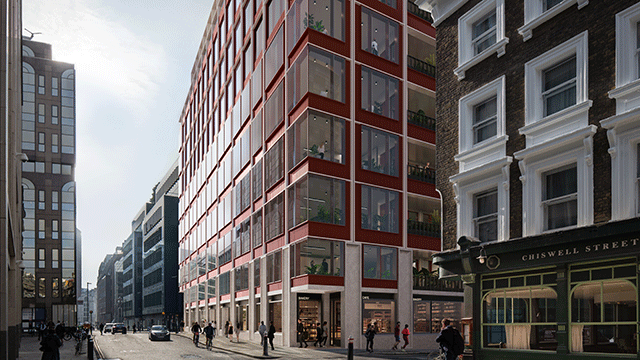Planning permission – Conditions – Flood risk – Appellant challenging grant of planning permission for residential development on land prone to flooding – Planning condition requiring submission and approval of surface water drainage system before development commencing – Whether condition complying with sustainable drainage principles – Whether respondent local planning authority misdirecting themselves as to meaning of condition – Appeal dismissed
In 2013, the respondent council granted conditional planning permission to the interested party developer for a residential development of 173 dwellings on land in the village of Menston, West Yorkshire. The development site was a sloping field crossed by a watercourse that flowed towards the adjacent housing. The appellant, a local action group, had objected to the planning application on grounds that included the likelihood of the development exacerbating the existing problem of flooding in the residential area.
The respondents imposed various conditions on the grant of planning permission in order to deal with the flooding issue. Condition 14 required a surface water drainage scheme to be designed and constructed to comply with the recommendations of a flood risk assessment which the interested party had submitted with its planning application, while condition 15 provided that the development was not to begin “until a surface water drainage scheme for water passing through the site, based on sustainable drainage principles, has been submitted to and approved in writing by the local planning authority”. The reason for the condition was to prevent flooding by ensuring the satisfactory storage/disposal of surface water from the site.
In August 2014, the respondent approved a drainage scheme for the development pursuant to condition 15. The appellant sought judicial review of that decision, contending that the approved scheme did not comply with condition 15. It contended that “sustainable drainage principles” would not be complied with unless it was demonstrated that the potential for reducing existing flooding, both on the development site itself and also in the surrounding area, had been considered. In support of that contention, it relied on the definition of “sustainable drainage” in para 2 of Schedule 3 to the Flood and Water Management Act 2010, which, it argued, showed that the concept of sustainable drainage principles embraced an aspiration to improvement rather than merely maintaining the status quo. It also relied on various planning policy statements and guidance documents issued by the government.
Dismissing the claim in the court below, the judge held that the respondents had not misdirected themselves in the application of sustainable drainage principles: [2015] EWHC 2292 (Admin); [2015] PLSCS 245. The appellant appealed.
Held: The appeal was allowed.
(1) The concept of “sustainable drainage principles” was not so widely familiar that the reasonable reader of a planning condition in which it appeared would, unaided, be confident in his understanding of it. The concepts of “sustainability” and “sustainable development” might now be generally understood, denoting the ability of something to be sustained and, in particular sense of the development of land, not making excessive demands on the environment. However, “sustainability” was a broad and versatile concept and whether development would be “sustainable” in any given respect would depend on the circumstances. The same could be said of the arrangements proposed for the drainage of a site when developed. A planning condition in which a local planning authority required a drainage scheme “based on sustainable drainage principles” would therefore require the “reasonable reader” to look at the specific context in which the requirement was imposed.
(2) Whatever the concept of “sustainable drainage principles” might mean in some other context, in the present context it did not, and could not, have the effect of requiring a surface water drainage scheme that would alleviate the existing problem of flooding beyond the boundaries of the development site. To construe the condition as requiring “betterment” of that kind would be to ignore the principles governing the imposition of planning conditions, as established in the case law and replicated in national planning policy in the National Planning Policy Framework and elsewhere. A condition requiring the submitted scheme to achieve some improvement in the drainage of other land next to the site, or nearby, would offend the principle that planning conditions should fairly and reasonably relate to the development permitted. It might also offend the principle that a condition must not be so unreasonable that no reasonable planning authority could have imposed it: Newbury District Council v Secretary of State for the Environment [1981] AC 578 applied.
(3) In order to interpret the words “sustainable drainage principles” in condition 15, it was not necessary to look beyond the terms of the planning permission itself and its relevant conditions, along with the documents expressly referred to in the permission, including the flood risk assessment referred to in condition 14: Trump International Golf Club Scotland Ltd v Scottish Ministers [2015] UKSC 74; [2015] PLSCS 362 applied. Condition 15 left it to the respondents to judge whether the submitted scheme for surface water drainage was based on sustainable drainage principles. It did not stipulate any improvement or betterment to the drainage of neighbouring land, or the alleviation of existing flooding beyond the boundaries of the development site, and it could not lawfully do so. The reason given for the imposition of the condition, namely to prevent flooding by ensuring the satisfactory storage/disposal of surface water from the site, had also to accord with those principles and could not extend to include the amelioration or elimination of existing flooding on neighbouring land. It could only mean “to prevent flooding arising from this development”, since it was to that development that the condition had fairly and reasonably to relate.
(4) Condition 15 had to be read with condition 14 and, therefore, with the flood risk assessment the recommendations of which had to be complied with in the surface water drainage scheme. While the flood risk assessment acknowledged the benefits of mitigating the existing flood risk and reducing the flood risk to gardens of properties bordering the development site, it could not legitimately be read, as a whole, as justifying a construction of condition 15 that would render it unlawful as a planning condition and at odds with national policy. It did not justify reading into the condition a requirement to reduce existing flooding outside the development site, which was more than it could properly require. Nor did it justify reading in a requirement for the interested party to consider, in the surface water drainage scheme submitted to the respondents, what scope there might be for doing more than a planning condition could require in that respect. The scheme envisaged under condition 15 was one of practical measures for the drainage of the site, consistent with the proposals in the flood risk assessment, not theoretical measures that might never be put into effect. That understanding of condition 15, as not requiring a surface water drainage scheme that committed the developer to reducing existing flooding outside the site or to considering how that might be achieved, avoided any conflict with the fundamental principles of law and policy relating to planning conditions.
(5) The appellant’s reliance on the provisions of the 2010 Act, and the various statements of policy and guidance to which it referred, was misplaced. None of those displaced the proper construction of the concept of “sustainable drainage principles” in the particular context of the particular planning condition and the planning permission on which it was imposed. The definition of “sustainable drainage” in para 2 of Schedule 3 to the 2010 Act was framed in very general terms, whereas, in condition 15, it had to have the specific meaning intended for it in that condition. The expression “based on sustainable drainage principles”, in the particular context of condition 15, could not mean “based on every principle that might qualify as a principle of sustainable drainage”.
David Wolfe QC (instructed by Schofield Sweeney LLP, of Bradford) appeared for the appellant; Vincent Fraser QC (instructed by the legal department of Bradford Metropolitan District Council) appeared for the respondents; the interested party did not appear and was not represented.
Sally Dobson, barrister






